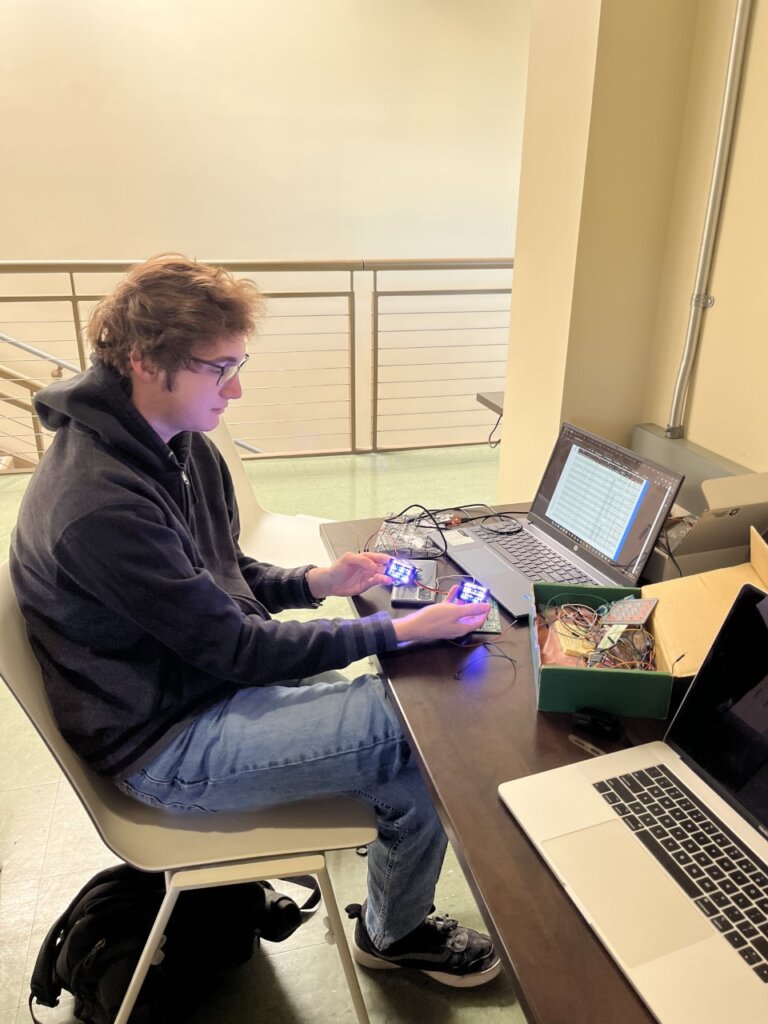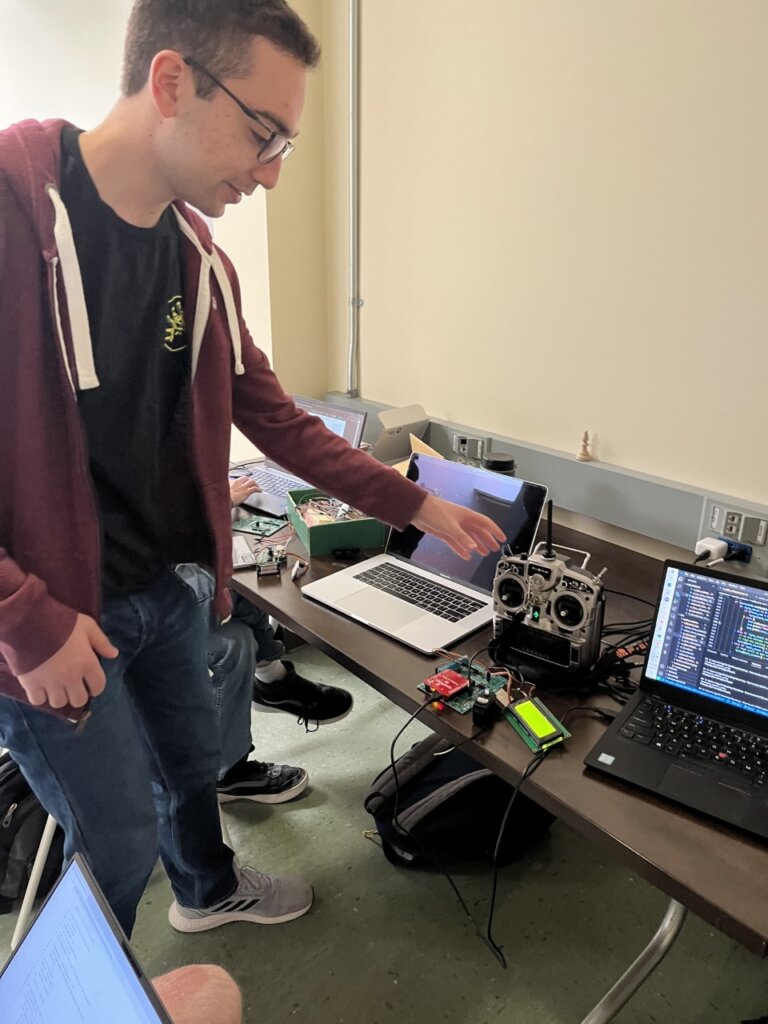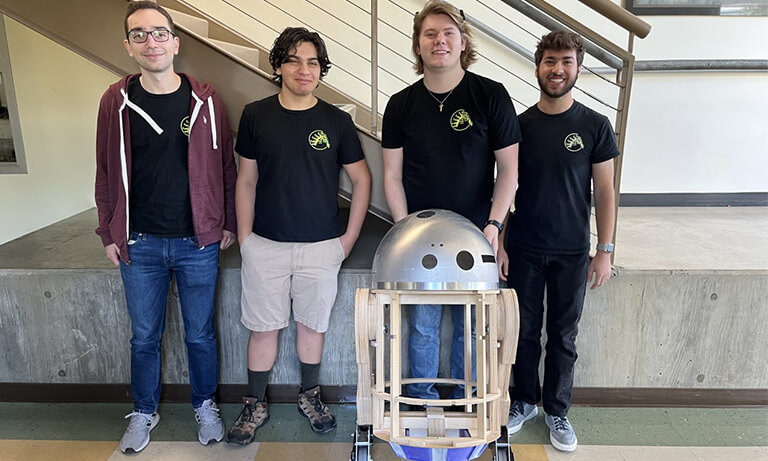Robotics Club Students Creating Autonomous R2-D2
Professor John Seng needed a project to jump-start the Robotics Club after COVID, so he turned to “Star Wars” for inspiration.
Having built Herbie – the college’s current autonomous robot – Seng was confident he could guide students as they built their own. He was also sure there was no better subject than R2-D2 – the beloved droid from a galaxy far, far away.
He proposed building an autonomous version of R2-D2 that could wheel and whistle around Engineering Plaza, an idea that was instantly embraced.
Students signed on to help, alumni pitched in to buy parts and a year later the robot they are calling Astromech has a wood frame, three wheeled legs and a metal dome.
By quarter’s end, Seng and the Robotics Club are hoping to test Astromech outside the Bonderson Projects Center, where he is under construction, and by the end of the year they want to see Astromech rolling around with both sound and lights.
“Astromech is designed to be a long-lasting project that can exist through the history of our club,” member Ethan Robin said of the only version of R2-D2 with a full computer the club found. “He is built with a level of complexity we know will last.”
Or, as member Colin Cook puts it, “We are building a robot that will keep getting cooler and cooler.”

‘INSANELY COOL’
Seng knew an R2-series astromech droid could captivate students and he was not wrong.
“Everyone is excited about this project, and we have plenty of people dedicated to it,” said Cook, a second-year mechanical engineering student. “By the time I graduate, Astromech could be insanely cool.”
While Robin, who is in his second year studying computer engineering, does not consider himself a diehard fan, Cook professes to be a “big ‘Star Wars’ nerd.” As proof, Cook shares memories of gathering with friends to watch the latest “Star Wars” series from Disney+ into the wee hours.
They both agree, however, that Astromech could be the club’s greatest robotics publicity stunt.
Seng is determined to build Astromech to the exact specifications of the movie version of R2-D2, although the first challenge was finding and buying all the droid’s parts.
Disney does not allow people to sell kits for R2-series astromech droids, but hobbyists around the world have built specific pieces with measurements from the movie model, selling them to would-be builders.
As Seng located parts from England to Ohio, rising costs compelled the professor to seek help.
In an innovative fundraising move, Seng sent out his spreadsheet to engineering alumni he knew, asking them to fund the purchase of a part or two. Or five, as in the case of an alum who stays grateful that Seng had allowed her to retake a pass/fail test.
In a matter of months, Seng raised thousands of dollars from eager donors.
‘ENDLESS POSSIBILITIES’
About 20-30 Robotics Club members congregate in the Bonderson Projects Center every Saturday to spend quality time with Astromech.
Downstairs, groups work on mechanical and electrical components, while upstairs, students work on software and programming.
“We make progress every week,” said Seng who moved from group to group on a recent Saturday, answering questions and drawing diagrams to relay concepts in robotics.
Cook and fifth-year mechanical engineering student David Dalal oversee the mechanical team which recently completed the 3-foot-6-inch droid’s wooden frame, while Robin leads the electrical team to power Astromech.
Christian Honein, who is in his third year studying computer engineering, is guiding the software team which will program sounds, lights, movements and even mannerisms.

“The possibilities are endless with the software,” Honein said.
Club members plan to find a list of R2-D2’s abilities from “Star Wars” movies, then decide what to add to Astromech.
Seng, for one, has big plans for the droid.
A T-shirt launcher could be rewired and attached to Astromech in Seng’s vision that includes the droid launching shirts into the crowd at Cal Poly basketball games.
A full sound system under Astromech’s legs could enable him to play music, while messages could scroll across the backside of Astromech’s dome. Holograms accessed through a QR code could even be in Astromech’s future.
First, though, Astromech will get his body and a paint job that incorporates Cal Poly colors, along with customized sounds that Cook hopes includes an R2-D2 scream.
Astromech’s neural network also must be trained with a series of images of Engineering Plaza so he can remember certain buildings and sidewalk areas – a complex process of data collecting and programming.
Dalal is particularly eager to see Astromech up and running, as he will graduate in December. But just because he will leave Cal Poly does not mean he will leave Astromech, Dalal said.
“I’m definitely coming back to work on him,” he said. “And years down the line, I’m coming back to see where Astromech is.”
Want to help?
The Robotics Club still needs funds to bring Astromech to life. People can give to the project by designating their donation as Robot Competition Support here.


